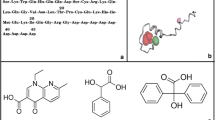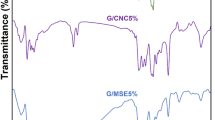Abstract
Nisin (0.2 IU per cm2 films) containing biodegradable films were produced from pea protein isolate (PPI), whey protein isolate (WPI), and polylactic acid (PLA). Nisin was released over 4 h at 22 °C and 8 h at 4 °C. PPI released more nisin compared to other films suppressing the growth of Listeria monocytogenes (P < 0.05) based upon diffusion into agar and liquid culture media. The population of bacteria after 48 h in liquid media was 6 CFU/mL (1 log10 increase) in PPI, 8.47 CFU/mL (3.47 log10 increase) in WPI and 9 CFU/mL (4 log10 increase) in PLA, which was significantly lower in protein based films compared to PLA (P < 0.05). The inhibition zone in agar test was significantly higher (P < 0.05) in PPI and WPI, compared to PLA film, which might be due to the higher hydration in protein based films. Fourier transform infrared spectroscopy (FTIR) showed that nisin altered the intensity of amide I peaks in protein based films suggesting that nisin can bind to the protein functional groups in PPI and WPI. Thermogram showed that nisin did not influence the glass transition and melting temperatures of the films. Nisin containing films exhibited significantly lower enthalpy compared to control films (P < 0.05). PeakForce Quantitative Nano Mechanical Property Mapping (PeakForce QNM) was applied to extract material and mechanical properties in PPI, WPI and PLA films with and without nisin. Results showed significant reductions in material and mechanical properties of protein based films containing nisin compared to PLA films.






Similar content being viewed by others
References
Aider, M. (2010). Chitosan application for active bio-based films production and potential in the food industry: review. LWT--Food Science and Technology, 43(6), 837–842. doi:10.1016/j.lwt.2010.01.021.
Al-Itry, R., Lamnawar, K., & Maazouz, A. (2012). Improvement of thermal stability, rheological and mechanical properties of PLA, PBAT, and their blends by reactive extrusion with functionalized epoxy. Polymer Degradation and Stability, 97(10), 1898–1914. doi:10.1016/j.polymdegradstab.2012.06.028.
Al-Qadiri, M. H., Sablani, S. S., Ovissipour, M., Al-Alami, N., Govindan, B., & Rasco, B. (2015). Effect of oxygen stress on growth and survival of Clostridium perfringens, Campylobacter jejuni, and Listeria monocytogenes under different storage conditions. Journal of Food Protection, 78(4), 691–697. doi:10.4315/0362-028X.JFP-14-427.
Appendini, P., & Hotchkiss, J. H. (2002). Review of antimicrobial food packaging. Innovative Food Science & Emerging Technology, 3(2), 113–126. doi:10.1016/S1466-8564(02)00012-7.
Bastarrachea, L., Dhawan, S., Sablani, S. S., & Powers, J. (2010a). Release kinetics of nisin from biodegradable poly (butylene adipate-co-terephthalate) films into water. Journal of Food Engineering, 100(1), 93–101. doi:10.1016/j.jfoodeng.2010.03.032.
Bastarrachea, L., Dhawan, S., Sablani, S. S., Mah, J. H., Kang, D. H., Zhang, J., & Tang, J. (2010b). Biodegradable poly (butylene adipate-co-terephthalate) films incorporated with nisin: characterization and effectiveness against Listeria innocua. Journal of Food Science, 75(4), 215–224. doi:10.1111/j.1750-3841.2010.01591.x.
Bastarrachea, L., Peleg, M., McLandsborough, L. A., & Goddard, J. M. (2013). Inactivation of Listeria monocytogenes on a polyethylene surface modified by layer-by-layer deposition of the antimicrobial N-halamine. Journal of Food Engineering, 117(1), 52–58. doi:10.1016/j.jfoodeng.2013.02.004.
Bernela, M., Kaur, P., Chopra, M., & Thakur, R. (2014). Synthesis, characterization of nisin loaded alginate-chitosan-pluronic composite nanoparticles and evaluation against microbes. LWT--Food Science and Technology, 59(2), 1093–1099. doi:10.1016/j.lwt.2014.05.061.
Cagri, A., Ustunol, Z., & Ryser, E. T. (2001). Antimicrobial, mechanical and moisture barrier properties of low pH whey protein-based edible films containing p-aminobenzoic or sorbic acids. Journal of Food Science, 66(6), 865–870. doi:10.1111/j.1365-2621.2001.tb15188.x.
Choi, W. S., & Han, J. H. (2001). Physical and mechanical properties of pea-protein based edible films. Journal of Food Science, 66(2), 319–322. doi:10.1111/j.1365-2621.2001.tb11339.x.
Choi, W. S., & Han, J. H. (2002). Film-forming mechanism and heat denaturation effects on the physical and chemical properties of pea-protein-isolate edible films. Journal of Food Science, 67(4), 1399–1406. doi:10.1111/j.1365-2621.2002.tb10297.x.
Cleveland, J., Montville, T. J., Nes, I. F., & Chikindas, M. L. (2001). Bacteriocins: safe, natural antimicrobials for food preservation. International Journal of Food Microbiology, 71(1), 1–20. doi:10.1016/S0168-1605(01)00560-8.
Cutter, C. N., Willett, J. L., & Siragusa, G. R. (2001). Improved antimicrobial activity of nisin-incorporate polymer films by formulation change and addition of food grade chelator. Letters in Applied Microbiology, 33(4), 325–328.
Dokukin, M. E., & Sokolov, I. (2012). Quantitative mapping of the elastic modulus of soft materials with HarmoniX and PeakForce QNM AFM Modes. Langmuir, 28(46), 16060–16071. doi:10.1021/la302706b.
Fabra, M. J., Sánchez-González, L., & Chiralt, A. (2014). Lysozyme release from isolate pea protein and starch based films and their antimicrobial properties. LWT--Food Science and Technology, 55(1), 22–26. doi:10.1016/j.lwt.2013.08.001.
Guéguen, J., Viroben, G., Noireaux, P., & Subirade, M. (1998). Influence of plasticizers and treatments on the properties of films from pea proteins. Industrial Crops and Products, 7(2–3), 149–157. doi:10.1016/S0926-6690(97)00043-5.
Ibarguren, C., Naranjo, P. M., Stötzel, C., Carina Audisio, M., Sham, E. L., Torres, E. M. F., & Müller, F. A. (2014). Adsorption of nisin on raw montmorillonite. Applied Clay Science, 90, 88–95. doi:10.1016/j.clay.2013.12.031.
Jin, J., Song, M., & Hourston, D. J. (2004). Novel chitosan-based films cross-linked by genipin with improved physical properties. Biomacromolecules, 5(1), 162–168. doi:10.1021/bm034286m.
Jin, T., & Zhang, H. (2008). Biodegradable polylactic acid polymer with nisin for use in antimicrobial food packaging. Journal of Food Science, 73(3), 127–134. doi:10.1111/j.1750-3841.2008.00681.x.
Jin, T., Liu, L., Zhang, H., & Hicks, K. (2009). Antimicrobial activity of nisin incorporated in pectin and polylactic acid composite films against Listeria monocytogenes. International Journal of Food Science & Technology, 44(2), 322–329. doi:10.1111/j.1365-2621.2008.01719.x.
Khan, A., Salmieri, S., Fraschini, C., Bouchard, J., Riedl, B., & Lacroix, M. (2014). Genipin cross-linked nanocomposite films for the immobilization of antimicrobial agent. ACS Applied Materials & Interfaces, 6(17), 15232–15242. doi:10.1021/am503564m.
Ko, A., Janes, M. E., Hettiarachachy, N. S., & Johnson, M. G. (2001). Physical and chemical properties of edible films containing nisin and their action against Listeria monocytogenes. Journal of Food Science, 66(7), 1006–1011. doi:10.1111/j.1365-2621.2001.tb08226.x.
Kong, J., & Yu, S. (2007). Fourier transform infrared spectroscopic analysis of protein secondary structures. Acta Biochimica et Biophysica Sinica, 39(8), 549–559. doi:10.1111/j.1745-7270.2007.00320.x.
Kowalczyk, D., & Baraniak, B. (2011). Effects of plasticizer, pH, and heating of film-forming solution on the properties of pea protein isolate films. Journal of Food Engineering, 105(2), 295–305. doi:10.1016/j.jfoodeng.2011.02.037.
Lee, S. H., Lefèvre, T., Subirade, M., & Paquin, P. (2007). Changes and roles of secondary structure of whey protein for the formation of protein membrane at soy oil/water interface under high-pressure homogenization. Journal of Agricultural and Food Chemistry, 55(26), 10924–10931. doi:10.1021/jf0726076.
Murillo-Martínez, M. M., Tello-Solís, S. R., García-Sánchez, M. A., & Ponce-Alquicira, E. (2013). Antimicrobial activity and hydrophobicity of edible whey protein isolate films formulated with nisin and/or glucose oxidase. Journal of Food Science, 78(4), M560–M566. doi:10.1111/1750-3841.12078.
Ollé Resa, C. P., Gerschenson, L. N., & Jagus, R. J. (2013). Effect of natamycin on physical properties of starch edible films and their effect on Saccharomyces cerevisiae activity. Food Bioprocess and Technology, 6, 3124–3133. doi:10.1007/s11947-012-0960-0.
Pintado, C. M. B. S., Ferreira, M. A. S. S., & Sousa, I. (2010). Control of pathogenic and spoilage microorganisms from cheese surface by whey protein films containing malic acid, nisin, and natamycin. Food Control, 21(3), 240–246. doi:10.1016/j.foodcont.2009.05.017.
Prapruddivongs, C., & Sombatsompop, N. (2012). Roles and evidence of wood flour as an antibacterial promoter for triclosan-filled poly (lactic acid). Composites Part B. Engineering, 43(7), 2730–2737. doi:10.1016/j.compositesb.2012.04.032.
Prombutara, P., Kulwatthanasal, Y., Supaka, N., Sramala, I., & Chareonpornwattana, S. (2012). Production of nisin-loaded solid lipid nanoparticles for sustained antimicrobial activity. Food Control, 24(1–2), 184–190. doi:10.1016/j.foodcont.2011.09.025.
Ramos, O. L., Reinas, I., Silva, S. I., Fernandes, J. C., Cerqueira, M. A., Pereira, R. N., Vicente, A. A., Poças, M. F., Pintado, M. E., & Malcata, F. X. (2013). Effect of whey protein purity and glycerol content upon physical properties of edible films manufactured therefrom. Food Hydrocolloids, 30(1), 110–122. doi:10.1016/j.foodhyd.2012.05.001.
Rossi-Márquez, G., Han, J. H., García-Almendárez, B., Castaño-Tostado, E., & Regalado-González, C. (2009). Effect of temperature, pH, and film thickness, on nisin release from antimicrobial whey protein isolate edible films. Journal of the Science of Food and Agriculture, 89(14), 2492–2497. doi:10.1002/jsfa.3751.
Salmasoa, S., Elvassoreb, N., Bertuccob, A., Lantec, A., & Calicetia, P. (2004). Nisin-loaded polylactide nano-particles produced by CO2 anti-solvent precipitation for sustained antimicrobial activity. International Journal of Pharmaceutics, 287(1–2), 163–173. doi:10.1016/j.ijpharm.2004.09.003.
Sebti, I., Delves-Broughton, J., & Coma, V. (2003). Physicochemical properties and bioactivity of nisin-containing cross-linked hydroxypropylmethyl cellulose films. Journal of Agricultural and Food Chemistry, 51(22), 6468–6474. doi:10.1021/jf0302613.
Sorrentino, A., Gorrasi, G., & Vittoria, V. (2007). Potential perspectives of bio nanocomposites for food packaging applications. Trends in Food Science and Technology, 18(2), 84–95. doi:10.1016/j.tifs.2006.09.004.
Teerakarn, A., Hirt, D. E., Acton, J. C., Rieck, J. R., & Dawson, P. L. (2002). Nisin diffusion in protein films: effects of film type and temperature. Journal of Food Science, 67(8), 3019–3025. doi:10.1111/j.1365-2621.2002.tb08853.x.
Walker, S. J., Archer, P., & Banks, J. G. (1990). Growth of Listeria monocytogenes at refrigeration temperatures. Journal of Applied Microbiology, 68(2), 157–162. doi:10.1111/j.1365-2672.1990.tb02561.x.
Zohri, M., Shafiee Alavidjeh, M., Haririan, I., Shafiee Ardestani, M., Ebrahimi, S. E. S., Tarighati Sani, H., & Sadjadi, S. K. (2010). A comparative study between the antimicrobial effect of nisin and nisin-loaded chitosan/alginate nanoparticles on the growth of Staphylococcus aureus in raw and pasteurized milk samples. Probiotics and Antimicrobial Proteins, 2(4), 258–266. doi:10.1007/s12602-010-9047-2.
Acknowledgment
This study was funded by USDA-NIFA 2011-68003-20096, and the Agricultural Research Center at Washington State University. We express our gratitude to Dr. Arda Gozen at Washington State University (Manufacturing Processes and Machining Lab) for providing us the facility to use AFM-PQNM for our nanomechanical testing.
Author information
Authors and Affiliations
Corresponding author
Rights and permissions
About this article
Cite this article
Shiroodi, S.G., Nesaei, S., Ovissipour, M. et al. Biodegradable Polymeric Films Incorporated with Nisin: Characterization and Efficiency against Listeria monocytogenes . Food Bioprocess Technol 9, 958–969 (2016). https://doi.org/10.1007/s11947-016-1684-3
Received:
Accepted:
Published:
Issue Date:
DOI: https://doi.org/10.1007/s11947-016-1684-3




